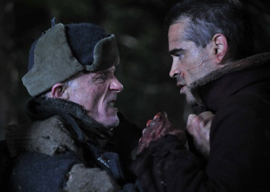
January 26, 2011

Ed Harris and Colin Farrell in The Way Back
To be Oscar-eligible, a movie had to have played for one week last year in Southern California. Last Christmas, I had looked forward to heading down to the ArcLight on Sunset Boulevard to a see The Way Back, a modest epic about an escape from a 1940s concentration camp. It’s the first film since 2003’s outstanding Master and Commander (which starred Russell Crowe as sea novelist Patrick O”Brian’s Captain Jack Aubrey) by distinguished director Peter Weir (Gallipoli, Witness, The Truman Show), the leading figure in Australian cinema’s emergence back in the 1970s.
But The Way Back‘s Oscar-qualifying run was not at the ArcLight Hollywood but at the AMC Covina 30. (I”m not sure where Covina is, other than that it is east, presumably, of West Covina.)
Now that The Way Back is finally out in a semi-national release on 678 screens, it turns out that its heroes were the wrong kind of 1940s political prisoners: A Polish Army officer leads six anti-communist escapees out of a Soviet Gulag in frigid Siberia (which will give you a new, favorable impression of global warming) across Mongolia and Tibet and over the Himalayas to India.
The well-trod ground of Nazism (1933-1945) automatically accords movies attention as “important,” while films about the fresher, broader topic of communism (1917-1991) must overcome the widespread attitude of “Why do we have to think about that?” Exceptional films such as The Lives of Others can overcome this aversion. For merely strong ones, such as The Way Back, Katyn, or last summer’s Farewell, popularity will always lie at the end of a hard road.
Anne Applebaum, author of Gulag: A History and a consultant on The Way Back, notes: “Weir told me that many in Hollywood were surprised by the story: They’d never heard of Soviet concentration camps, only German ones.” You can see how much Weir had to scrounge for his $30-million budget during the interminable opening display of animated logos for the seven obscure production companies that chipped in, including National Geographic Films, the Polish Film Institute, and Imagenation Abu Dhabi.